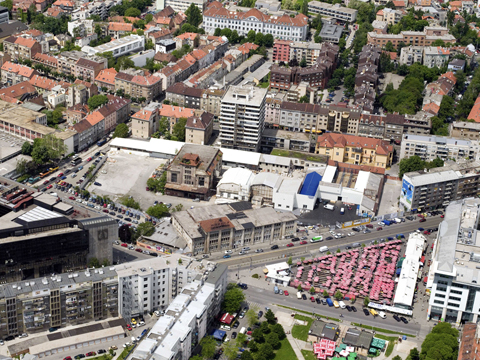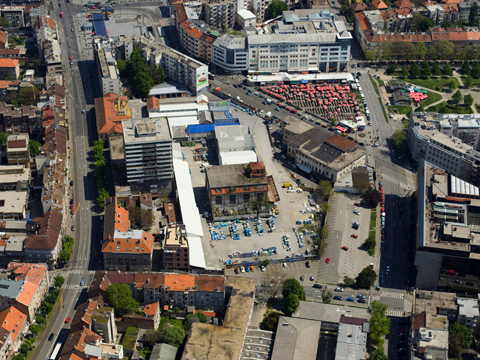Natječaj Blok Badel
Podsjetnik za prijave na kolokvij i obilazak lokacije Bloka Badel
Autor/izvor: DAZ 31/01/2012
U sklopu natječaja Blok Badel DAZ organizira stručni skup i obilazak lokacije. Stručna predavanja će se održati 7.2.2012. s početkom u 9.30h u prostorima Društva arhitekata Zagreba, nakon čega će se ići na pregled lokacije. S obzirom na veliki interes za ovaj natječaj molimo Vas da svoje prijave za sudjelovanje pošaljete do četvrtka, 2.2.2012.
Potaknuti željom da se svi zainteresirani što bolje upoznaju s temom, natječajnim programom i mogućnostima prenamjene industrijske arhitekture, kao i očekivanjima i planovima investitora vezanim na tu lokaciju, DAZ organizira stručni skup i obilazak lokacije na temu Blok Badel. Stručna predavanja će se održati 7.2.2012. s početkom u 9.30h u prostorima Društva arhitekata Zagreba, nakon čega će se ići na pregled lokacije.
Molimo sve zainteresirane da se registriraju na e-mail mladena.belamaric@d-a-z.hr,
sa podacima:
- ime i prezime
- zemlja iz koje natjecatelj dolazi
S obzirom na veliki interes za ovaj natječaj molimo Vas da svoje prijave za sudjelovanje pošaljete do četvrtka, 2.2.2012.
Ovdje pogledajte program kolokvija i obilaska lokacije.
Službena stranica natječaja Blok Badel.
Predavanja će održati Irena Matković, Tamara Rogić, Goran Arčabić i Marina Bagarić.

U nastavku pogledajte koje su teme predavanja i životopise predavača.
Irena Matković: Badel Block Competition - Purpose, Expectations, Outcomes
The presentation will give a brief overview of:
- Challenges and objectives in urban developmentof City of Zagreb
- Spatial/ development resourses on the edges of the historical nucleus: 3 locations of the abandoned old industry
- Zagreb Masterplan giudelines: definition and objectives of city project
- Procedures required: what follows the competition?
- Position of Badel Block in the wider city area
- Latest developments in the immediate surroundings
Irena Matković - CV
Head of the Department for Strategic Planning at the Office for Strategic Planning and Development of the City of Zagreb.
Educational background: Graduated architecture in 1995 at the University of Zagreb, and earned her MSc degree in the field of urbanplanning in 2011, at thepostgraduatestudies atthe University of Zagreb - Faculty of Architecture.
Professional background: Professional experience covers the topics and tasks related to the regional and urban planning for City of Zagreb, including coordination of Development plans and Masterplan design process. She has been the author of several articles, as well as a lecturer and a participant in various conferences and panel discussions. Recently she is coordinating the design process of ZagrebPlan (Development strategy for the City of Zagreb).
Tamara Rogić: Beautiful "Buildings Called Factories"
When OMA propose walls to be moved in order to retain visible the building structure of the protected Zollverrein Kohlenwasche (Germany), the walls are moved. OMA’s points of negotiation with the conservation officers are a perfect example of the inability of the existing guidelines for reuse of industrial buildings to guide the conversion design. Alteration of the guidelines is particularly needed in the case when the existing industrial building and related site need to be converted into a use other than a museum of the industrial branch to which the building and the site originally belonged.
In general, architects do not like conservation guidelines. However, it is important to be familiar with them there where they cannot be avoided. Conversion of protected industrial buildings is such a case. The challenge will be how to reinterpreted and altered the conversion guidelines in order to be useful for architects. We all know how Hertzog&deMeuron achieved this in the Tate Modern. Would the other five offices participating to the Tate Modern competition manage the same? Let us find out!
Tamara Rogić - CV
Tamara Rogic, architect, graduated from Faculty of Architecture in Zagreb works as a free lance researcher and consultant on the matters of urban renewal since 2009. Tamara developed an interest for the management of the urban environment through her work in the Department for Protection of Cultural Heritage, Ministry of Culture of Croatia where she preformed research and managerial tasks for conducted conservation studies. These studies result in recommendations for protection of the given area and/or town and are used as strategies for possible future developments within the masterplan of the area or town in question. Tamara deepens further her involvement with the management of the urban environment by specializing in the care for abandoned industrial sites in particular, focusing her interest on matters related to redevelopment and refurbishment of these properties. Tamara combines her research work with lecturing at universities across Europe.
Goran Arčabić: Industrial Heritage - Cultural Capital and Development Potential
Finding different uses for industrial buildings has become the backbone for the development of numerous cities and regions throughout the last three decades. The potential of abandoned factories and their associated infrastructure has been unlocked to provide a basis for urban, economic, demographic and environmental regeneration of once productive areas. In accordance with the needs of a post-industrial society, traditional areas of industrial production have continued as a nexus for the development of the service sector or have been transformed into incubators of new technologies. It is precisely the functionality of these industrial facilities that allows them to be redeveloped.
This presentationshows three examples of the reuse of industrial complexes from across Europe. One was the comprehensive IBA Emscher Park Project which, at the beginning of the 21st Century, provided the preconditions for the sustainable development of a previously contaminated, economically exhausted and depopulated area of the German Ruhr Valley. Another project, Elektropolis Berlin, showed the possibilities of harmonizing public and private sector interests. This innovative approach to managing Berlin’s architectural heritage sites, owned by the then Berliner Städtische Elektrizitätswerke Akt.-Ges. – BEWAG, provided ‘reinvigoration’ of these formerly technologically obsolete buildings, which in turn helped to promote a positive corporate image. The Finnish City of Tampere is the final example, which demonstrates the transformation of a Scandinavian industrial centre into a dynamic 'City of Museums' and new technologies.
The projects presented show the balance between the protection of monuments, public needs and the interests of investors. These applied models of industrial heritage management are typified by the sustainable, thoughtful 'reuse' of industrial buildings and landscapes, maintaining characteristics that will become synonymous with the local community. The choice of Essen as the 2010 European Capital of Culture shows that the revitalization of the Ruhr Valley surpassed the regional level, confirming the importance of industrial heritage in building a common European identity.
Goran Arčabić - CV
The Senior Curator of the Zagreb City Museum, Head of the ‘Zagreb Industrial Heritage: History, State-of-Affairs, Outlook’ Project. Since 2004, he has been working as a curator of the Zagreb City Museum and has been the Head of the 'Zagreb Industrial Heritage: History, State-of-Affairs, Outlook' Project since 2009. His professional interests include: the economic and social history of the 19th and 20th Centuries and the history of labour and industrial heritage. He is a member of the International Committee for the Conservation of Industrial Heritage (TICCIH) and the International Council of Museums (ICOM), and an author of several study exhibitions. His papers have been published in scientific and professional periodicals. He graduated in History from the University of Zagreb and is currently a postgraduate student.
Marina Bagarić: Badel Site Before Badel - Building History of an Industrial Complex (1915–1945)
Building of the factories at the edge of commercial and residential eastern part of Zagreb was officially allowed up to 1936. In reality, system of city blocks based on Lenuci's 1905 urban design for eastern part of the town strongly determined dimensions and the mode of development of the industrial complexes.
At the very beginnig of the World War I, wine merchant and manufacturer Mijo Arko decided to move his facilities from the old town of Zagreb to the eastern part of the city. He bought an old house in Vlaška street and rebuilt it for his new office and family residence. In 1917 he built a small building for the cognac factory behind the house. At the same time Mijo's son Vladimir purchased adjacent parts of the site and, between 1918 and 1921, built there a new factory building for manufacturing "liqueur, cognac, brandy, spirits, champagne, yeast, soft drinks andbarrels".
At the same time Vladimir Arko again rebuilt his father's house in Vlaška street. For both projects – plant and office/residential building, Arko engaged Ignjat Fischer - architect, famous for his architecturalversatility andability to adapt tothe specificmicro-location.In thefactory buildingprojectsFischerconnected suspended reinforced concrete supportstructuretothe facade with multitude of windows, typical for modern industrial architecture. He designed the decorative details of the facade in the spirit of Art Nouveauera. On the contrary, the family residence was redesigned as a sumptuous neo-historical palace.There was a romantic private park between the residence and Kvaternik square.
But Vladimir Arko's successful businessand the continual introductionof newtypes of productsduring the 1920srequired theerection of newfactoryfacilities in the limited site. In the 1920s and early 1930s in the private park and around Fischer's factory buildings industrial complex grew chaotic: ether factory, steel barrels factory, aluminium barrels factory, laboratory, workers' residential buildings and warehouses were built mostly without any architectural quality. In 1938 Arko moved his productionto the neighbouringvillage of Leskovac.After WW II Arko's factory was confiscated and named after Marijan Badel, communist and war hero whose father was wine merchant and manufacturer as well. During the decades after the war now Badel site remained in almost unchanged condition.
Marina Bagarić - CV
Marina Bagarić is Curator and Head of the Architectural Department at the Museum of Arts and Crafts in Zagreb. Collaborates on research projects of the Institute of Art History Zagreb and of Croatian Academy of Science and Art. She is the author of numerous scientific papers and essays on architecture and ceramics art in journals and museum publications. Member of the editorial board and expert commitee of the exhibitions Art Nouveau in Croatia (2003) and Art Déco and Art in Croatia between the two wars (2011). In 2011 she published book Architect Ignjat Fischer, awarded by Croatian Architects’ Association. She completed studies of Art History and Russian language and literature at Faculty of Philosophy – Zagreb University. PhD on history of architecture in 2010.

 Društvo
Društvo Društvo
Društvo